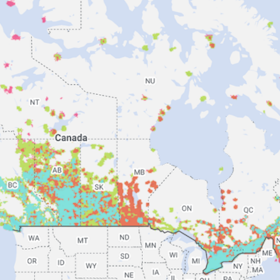
Using video on your phone—be it with your camera or watching YouTube—is about as common as making a phone call these days, but is there really a noticeable difference between standard definition (SD) and high definition (HD)?
We'll go over the ins and outs surrounding both formats and what it means for your data plan and mobile device storage.
HD vs SD: What’s the Difference?
When referring to “SD” and “HD,” terms like these often represent general camps of video quality, rather than specific types of resolution. You’ve probably even seen them all listed on your favorite video platform (think YouTube’s quality tab in the lower right-hand corner of the video).
Important note to remember
High definition can actually be divided up into two separate tiers, with the newest and most impressive formats falling into an upper-tier—better known as ultra-high definition or “UHD” (4K video resolution and above)
“SD” stands for “standard definition,” and is largely considered the video resolution of yesteryear—primarily being used for older technologies and displays (think tube TVs and VHS).
Standard definition videos can be broken into a number of different formats—such as:
- 480p (352 x 240 pixels)
- 360p (480 x 360 pixels)
- 240p (352 x 240 pixels)
"HD," on the other hand, stands for “high definition” and is the new standard for most forms of technology currently—from smartphones to laptops to tablet devices.
High-definition video is broken into different formats as well. The most common HD formats right now are:
- 720p (1280 x 720 pixels)
- 1080p (1920 x 1080 pixels)
- 2160p/4K (3860 x 2160 pixels)
HD vs. SD: Understanding Pixels, Resolution, and Aspect Ratio
Pixels, resolution, and aspect ratio are common terminology used when referring to video quality, and they are all very closely related to one another. The easiest way to understand and differentiate the three are as follows:
- Pixels are the individual dots—or "micro-illuminations"—that make a digital video or image on a screen. The pixels of an image are indicated by the dimensions you see in the formats above (1920 x 1080, for instance) and refers to both the horizontal and vertical axes on a given display.
- Resolution, on the other hand, typically refers to the number of pixels per square inch (PPI) or the total number of pixels for an image or video. Higher resolution usually equates to higher image quality overall, thanks to the overall pixel density. This means that each individual pixel is smaller and more detailed, resulting in more consistent picture quality overall, regardless of screen size. Lower pixel count means pixels must stretch to cover more area on a given display, which is why you’ll end up with “grainy” images with low resolution images/video on larger screens.
- Aspect ratio (often written as simply "AR") is the ratio used when creating film or videos and influences how specific videos are displayed on a device. The industry standards for aspect ratio are typically 4:3 and 16:9. Aspect ratio is different from resolution in that resolution is only referring to pixels, whereas the aspect ratio is referring strictly to the dimensions of the video and/or screen (think iPhone vs. iPad vs. computer monitor screens).
When dealing specifically with smartphones, some would argue that higher resolutions beyond HD and Ultra HD are wasted, as the size of most phone displays can’t make proper use of the pixel density. This is inconclusive, though, and a number of industry enthusiasts claim to see notable differences—even at the highest resolutions. There are definitely improvements when jumping from SD and HD, but whether the jump is worth investing in is another story for many.
HD vs. SD Data Usage and File Size
Two of the most obvious differences in SD and HD video are the amounts of data used when streaming, and the file sizes of recordings. Below is a general breakdown for data consumed per hour of streaming based on the resolution:
Streaming Data Usage by Video Resolution
| Video Resolution | Data Amount |
|---|---|
| 4K | ~7GB/hour |
| 1080p | ~1.5GB/hour |
| 720p | ~0.9GB/hour |
| 480p | ~0.7GB/hour |
| 240p | ~0.3GB/hour |
Similarly, here’s a breakdown for expected file sizes when recording in different resolutions. Keep in mind that frame rate, or frames per second, affect file size as well—usually the higher the frame rate, the larger the file size.
File Size by Video Resolution
| Video Resolution | Data Amount |
|---|---|
| 4K | ~24 GB/hour (h.264/.mp4) |
| 1080p | ~7.6 GB/hour (h.264/.mp4) |
| 720p | ~3.5 GB/hour (h.264/.mp4) |
HD vs SD Data Plans for Streaming
Mobile carriers will typically offer plans with specific quality restrictions for video streaming, with upper-tier plans offering higher resolutions, and lower-tier plans offering lower resolutions. These limitations are important to make note of, as they use the same data pool as other online activities in most cases.
This isn’t much cause for concern with unlimited plans, but most carriers' data plans have deprioritization thresholds that go into effect once you’ve used a specific amount of data in a given month. Deprioritization can be best described as the potential temporary slowing of your data speeds during times of congestion. Some plans will deprioritize your data at any time, while others specify a monthly threshold that resets each billing cycle.
Depending on your plan's data allotments, you’ll want to be mindful of how quickly streaming video can add up in the data department—particularly if you are on a data-limited plan.
SD/HD Video Resolution and Battery Life
When it comes to smartphone battery life, the difference in HD and SD streaming/playback is significant. Like the chart above shows, HD streaming can run you almost 1GB/hour when streaming. This means that your phone must process tons of data, very quickly, in order to provide you with a worthwhile viewing experience. That said, HD video saved directly to your device can provide improved results overall, but your device still needs to process the data, meaning battery life will still suffer a great deal.
Alternatively, SD video will often save you a bit of battery life when compared to HD videos, but how much will depend on how low quality your stream/saved video is. For instance, a 480p stream will use about half the data of a 1080p stream over the same period of time, resulting in far less data needing to be processed. This still pales in comparison to an even lower resolution like 240p—likely ruining your viewing experience, to some degree, but saving you tons on battery life in the process.
How Good Is 4K Video?
Even though resolutions higher than 4K currently exist (though aren't as widely available), 4K is still the standard for high-end displays and video resolution in general. The reason that 4K is so impressive is largely due to the pixel count—over 8 million in total, 4,000 of them being in the horizontal axis. Many manufacturers are beginning to see 4K as the industry standard, with newer iPhones and Galaxy devices handling the format with relative ease.
The biggest drawback to 4K video currently is data usage, related to both streaming and storage. We already mentioned how massive 4K files are in the charts above; however, future implementations of 5G networks and increased phone storage may make the resolution more universally viable in years to come.
SD vs. HD: Common Streaming Apps
There are tons of apps that use video streaming in the modern era—Zoom, YouTube, IPTV, and Twitch just to name a few. All of these streaming applications favor specific resolutions to make the user experience just right. Below is a video resolution chart that looks at some of the differences across the most popular streaming apps available right now.
Common Streaming Apps
| Platform | Things to Know |
|---|---|
| The ideal Facebook video resolution is 720p when uploading to the platform, meaning HD streaming is the preferred resolution in this case. Facebook will automatically lower your video resolutions if your connection requires it, though. | |
| Instagram’s video resolution functions very similarly to Facebook’s—which makes sense, considering that Facebook now owns the app. Instagram, however, favors 1080p as its default resolution, but will still lower video resolutions when applicable to suit your connection speeds. | |
| YouTube | YouTube video resolutions are the most versatile of any app in this chart, going as high as 8K—although this is rare. Keep in mind that when you increase video resolution to 4K or higher, you’re not only at risk of using tons of data, but also killing your battery life in the process. Fortunately, you can change video resolutions at any time with the cog icon settings at the bottom of the video. |
| Zoom | Since this platform focuses almost entirely on live streaming, Zoom video resolution usually tops out at 720p for standard accounts. You can, however, increase video resolution to 1080p in special cases through Zoom’s support—for things like sizable live video conferences. |
| TikTok | Like Instagram, TikTok’s preferred video resolution is 1080p; however, TikTok specializes in much shorter videos (15 seconds max), so higher resolution streaming is less of a concern when it comes to data. |
Is HD or SD Streaming Right for You?
Whether or not you’ll need SD or HD streaming is entirely dependent on your viewing habits—some of us will need better resolutions for certain activities, while others can get away with minimal requirements. If you’re simply browsing YouTube for funny cat videos, or scrolling through Instagram to watch your favorite influencer’s live streams, you can probably get away with standard definition videos more often than not. Alternatively, if you have high-stakes business meetings on Zoom, or are the one that is actually doing the live streaming with your camera on social media, high definition will typically better serve your needs.
Regardless of which route you choose, you’ll need a data plan for your phone to be able to take advantage. Some phone plans specify whether they include SD or HD streaming, so read the fine print! Our coverage tool compares data plans —big and small—letting you get the most for your hard-earned money. We’ve also listed a number of popular data plans below to help set you in the right direction—take a peek:
Related Articles
Find Better Phones and Plans
Hundreds of cell phone plans unpacked. All the facts. No surprises.












































